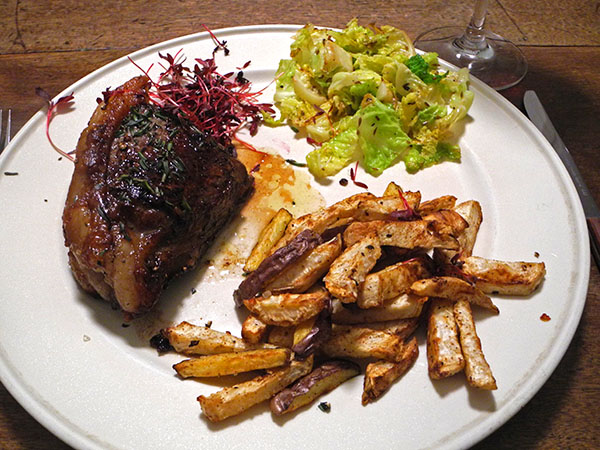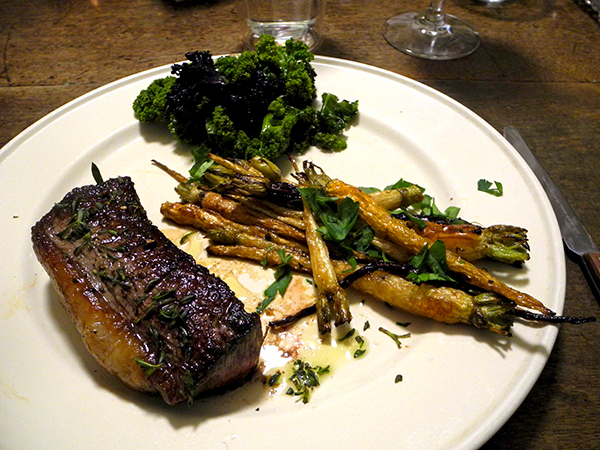
It’s possible my memory is blurred, but until I can be persuaded otherwise, I’m going to say this was the best steak I’d ever had.
The cut itself (called ‘culotte’ here, ‘coulotte’ in France, ‘picanha’ in Brazil) has become my favorite, certainly for its flavor but also for the kind of chewiness I enjoy in good beef; ‘melt in your mouth’ is not what I look for.
Adding to its attractions is the fact it seems to come with a consistency in size, and, because I’ve been instructed in a routine which brings it to our preferred degree of doneness (more medium than medium-rare, with this particularly lean cut), there’s little anxiety about the cooking process, since it seems to come our perfectly each time, letting me pay more attention preparing the side dishes, even shortly before serving.
- * one 20-ounce culotte steak from Gabe, of Sun Fed Beef (Maple Avenue Farms) in the Union Square Greenmarket, cut crosswise into 2 pieces, brought to room temperature, seasoned on all sides with good sea salt and freshly-ground black pepper, seared briefly on the top, the fat side (almost half of the fat will be rendered in the cooking, the rest will make it taste wonderful), then cooked for about 4 minutes on each side, before the bottom side was seared briefly, removed from the pan, and placed on warm plates, drizzled with juice from an organic Whole Foods Market lemon and some olive oil, sprinkled with chopped winter savory from Stokes Farm and allowed to rest for about 4 minutes, garnished with Micro red amaranth from Two Guys from Woodbridge

- * roughly 10 ounces of celery root from Norwich Meadows Farm, combined with 2 small ‘Peter Wilcox’ white-fleshed purple potatoes from Windfall Farms to make up about 3 quarters of a pound in total, since I had used a bit of the celeriac in an earlier meal, scrubbed, peeled, and cut into the size and shape of potato frites, tossed in a bowl with olive oil, a half teaspoon of Spanish paprika picante, a small crushed section of an orange/gold habanada pepper, sea salt, and freshly-ground pepper, spread out onto a medium-size Pampered Chef unglazed ceramic pan, roasted at 400º until brown, crispy on the edges, and cooked through
- one very small head of Savoy cabbage from Tamarack Hollow Farm, washed, quartered, cored, sliced into one-half-inch ribbons, sautéed in a scant tablespoon of olive oil inside a medium heavy, tin-lined copper pot until wilted but still crunchy, stirring occasionally, seasoned with sea salt and freshly-ground black pepper, a little more than a teaspoon of toasted cumin seed, added to the cabbage and mixed in, finished with half a teaspoon of Columela Rioja 30 Year Reserva sherry vinegar, stirred and cooked another couple minutes
- the wine was a Spanish (Duero) red, Bodegas Gormaz Joven, Ribera del Duero 2013, from Philippe Liquors
- the music was Bohislav Martinü’s Symphony No. 4, Cornelius Meister conducting the Vienna Radio Symphony Orchestra



